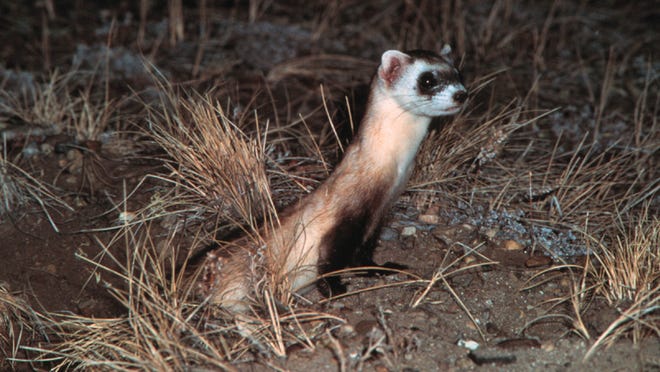Desert lizard could be protected by feds from oil and gas 'wreckage' following lawsuit
 Adrian Hedden
Adrian Hedden
A small, rare lizard in the deserts of southeast New Mexico was believed imperiled by oil and gas drilling in the Permian Basin, the U.S.’ busiest fossil fuel region.
The dunes sagebrush lizard historically dwelled throughout the region, in the high deserts that span into West Texas but were frequently disturbed in recent years by extraction operations like drilling rigs, wells and sand mining.
The threats to the lizard could worsen as energy production in the basin that makes up almost half of the U.S.’ 11 million barres of oil produced daily was expected to increase, amid increased demand for U.S. fuel following the COVID-19 pandemic and Russia’s exit from the global market.
More:Oil and gas threatens lizard native to southern New Mexico. Here's what's being done

That’s why the U.S. Fish and Wildlife Service agreed to make a final decision on federal protections for the lizard in about a year, setting a deadline of June 29, 2023 to list the species as either endangered or threatened under the Endangered Species Act.
An endangered listing means a species’ extinction is imminent and restricts some uses of land believed within the animal’s existing habitat or where its range could expand as its population expands.
Threatened status means a species’ condition could soon warrant an endangered listing and entails some but less-restrictive restrictions.
More:Would protecting a rare bird in New Mexico threaten the state's oil and gas drilling?
Both potential statuses for the dunes sagebrush lizard drew concern from the oil and gas industry and its supporters as federal action that could stymie the industry viewed as a crucial segment of New Mexico’s economy as it provides up to a third of the state’s budget.
But Michael Robinson with the Center for Biological Diversity said a listing was crucial, despite economic ramifications, to protect the species and the broader environment in southeast New Mexico.
“The dunes sagebrush lizard will go extinct if the species doesn’t get Endangered Species Act safeguards from the environmental wreckage caused by the oil and gas industry,” he said. “I’m relieved that these intrepid little lizards are finally getting another shot at protection.”
Opinion:Oil and gas, landowners and CEHMM work together to keep working
The Fish and Wildlife Service’s Aug. 25 decision to consider a listing for the lizard followed a lawsuit filed by the Center in May, arguing the agency delayed its decision-making on a petition the Center filed in 2018.
A required 12-month finding was not issued a year after that, read the suit, and threats to species grew in the years since as oil and gas operations expanded.
The agency did issue a 90-day finding in 2020 for the 2018 petition, contending the lizard could warrant a listing, per the suit, but had not acted since.
More:Dirty air in Eddy County oilfields could trigger federal Permian Basin-wide restrictions
An initial petition was filed by the Center to list the sagebrush lizard for federal protection in 1982, and the Fish and Wildlife Service proposed it be listed as endangered but later declined to do so in 2012, records show.
The lizard disappeared from up to 86 percent of sites it previously occupied, per the suit, and 35 percent of its remaining habitat was “compromised” by oil wells within its range.
Mining for sand used in oil and gas drilling led to a loss of up 1,000 acres a year of lizard habitat, read the suit, and damaged potential habitat where it could expand.
More:Thousands of animals are killed on New Mexico roads. What is the State doing about it?
More lizards could be lost, the suit read, as present regulatory mechanisms were allegedly “inadequate” to prevent damage from oil and gas and nearby agriculture operations.
“The dunes sagebrush lizard’s habitat has declined, is fragmented, and is immediately threatened by oil and gas development, sand mining for fracture drilling operations, and exposure to herbicides and livestock grazing from the conversion of shinnery oak habitat to agriculture,” read the suit.
Robinson said federal protections were needed immediately to protect any further damaged to the species and prevent its extinction.
More:Herrell pushes bill to pay back New Mexico ranchers for livestock attacked by lobos
He said this was more important than the bottom lines of oil and gas companies.
“Wildlife officials can’t let big oil and gas interests smooth-talk them out of protecting the dunes sagebrush lizard again,” Robinson said. “We’re in the middle of an extinction crisis, and every day counts.”
In New Mexico, Carlsbad-based nonprofit the Center of Excellence (CEHMM) worked to protect the lizard by partnering with the oil and gas industry and private landowners on conservation projects in hopes of avoiding a federal action.
More:Native flower extinct in New Mexico could be brought back through federal protections
This took the form of candidate conservation agreements, contracts approved by the Fish and Wildlife Service to require landowners engaged in certain conservation practices in exchange for being insulated from restrictions resulting from a listing.
During a June field survey, CEHMM reported no dunes sagebrush lizards were found, per its report on the second quarter of 2022.
Throughout Q2, unused oil and gas infrastructure like roads, caliche pits and well pads were removed from the lizard’s habitat.
Since 2009, CEHMM reported 587 wells were removed from the lizard’s range, along with 92 rights of way that allow operations to cross between state and federal lands.
A total of 732,180 acres of dunes sage brush habitat lands were enrolled in the conservation agreements, CEHMM reported, about 84 percent of the 869,699 acres making up its habitat in New Mexico.
Adrian Hedden can be reached at 575-628-5516, achedden@currentargus.com or @AdrianHedden on Twitter.